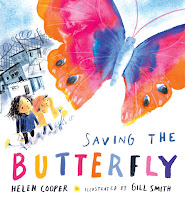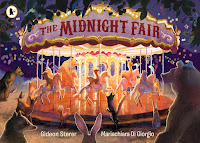A little brother and his big sister try their best to settle in a new home, where they have nothing left from before except each other. The little one makes new friends and quickly learns to laugh again but his sister remains haunted by the shadows of their past and hides away in their broken house. Trying to help his sister, the little one catches a butterfly for her and brings it inside the house. His sister knows that she needs to set the butterfly free ... but that would mean going outside. In taking the first steps to face her fears and save the butterfly, she also begins the process of saving herself.
Many of my books are a gentle look at childhood anxieties: the fear of losing someone or being lost, or even the fear of a bear living under the stairs. I was an anxious child, so I try to tread lightly, with humour to counter the theme. But when Denise Johnstone-Burt at Walker Books asked if I could write a picture book text about anxiety for another illustrator, I knew here was an opportunity to write something more serious and symbolic: a story that might work best with a looser and more suggestive style of illustration than my own.
Early on a brother and a sister came to mind: a resilient, chirpy younger child and his older sister who copes admirably for both of them in a crisis but afterwards suffers from anxiety and her memories of the past. I'm always interested in the manner different characters react to the same situation. This is the heart of the story. The lyrical phrases that I'm searching for when I write a picture book surfaced when I thought of using a butterfly as a metaphor for the girl's courage: I knew a butterfly could be a strong symbol for fragility and the spirit of survival. Then came the imagery of the dark sea to represent trauma and the rhythm flowed.
But I had intended to write more universally about anxiety. My characters had evolved into refugees who had lost everything. There could be no easy resolution for them. And although the dark sea is meant to represent any sort of trauma - and all the dark seas that people have fled from in the past, as well as now - I felt daunted. I worried about winding myself into some real person's tragedy. For a while, I put the story aside.
I am not a refugee, although my parents on both sides were the children of immigrants, Jewish on one side, Irish catholic on the other. Both families came over the sea with very little and found refuge in this country. I think about that often. In the end, I returned to the story because the need for home and safety and kindness is so universal. This is a gentle tale of two children saving a butterfly. And though the hope at the end of the story is fragile I hope that with Gill Smith's poignant illustrations it might become a book that children will want to share.
Can you tell us a little bit more about the writing process and what was it like to see Gill Smith’s illustrations for the first time?
This is the first book I have written but not illustrated. Just now I am working on fiction for older children, but I've been missing picture books. The prospect of collaborating with another illustrator was really intriguing. I'm most comfortable when writing in picture book form so my stories tend to be shaped around natural page turns. But apart from that structure I only allowed myself the haziest ideas about the artwork: darkness for the sea and shadows, with a rainbow brightness for the butterfly. To imagine more might have spoiled my reaction to what an illustrator could bring to the story and I was really keen not to get in their way.

Louise Jackson, the art director, sent Gill Smith's first black and white roughs during the first Covid lockdown. I was thrilled. They were stunning: simple yet strong; sensitive, and well-composed with gorgeous figure work. I had only one worry. Would she be able to carry that emotional intensity through to final full-colour art? That can be tough.
But the final artwork was even better than I had hoped. The illustrations are gorgeous: spacious and powerful, gentle and compassionate all at once; Gill's figures are her forte, especially those so simply indicated faces full of emotion. Collaborating with Gill on this book has been a joy.
Saving the Butterfly is now available from all good booksellers.






















